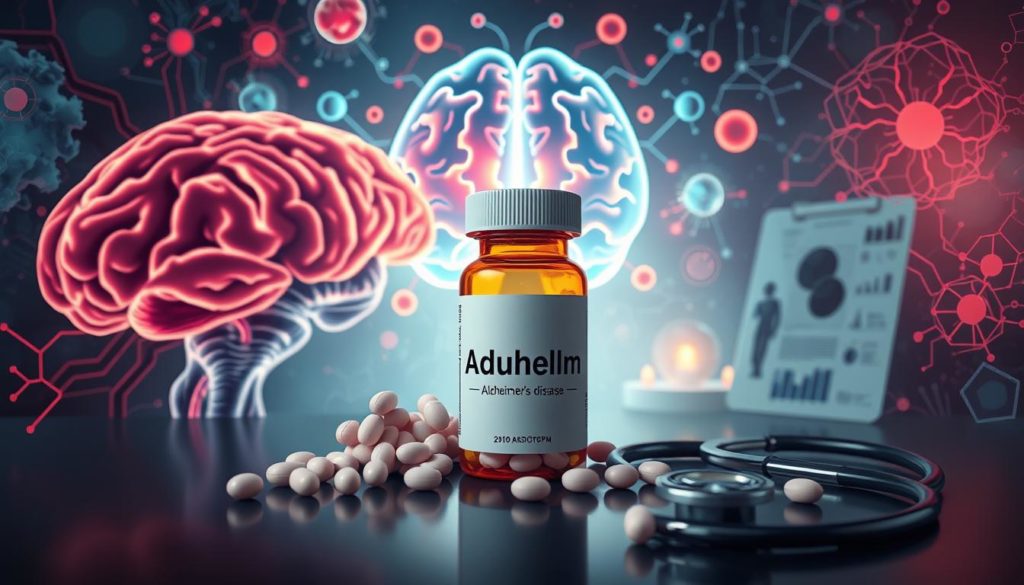Did you know over 6 million Americans have Alzheimer’s? This number shows how much we need effective treatments like Aduhelm. It’s a new medicine that targets amyloid plaques in the brain. Let’s dive into how Aduhelm works and its effects on slowing down cognitive decline.
Biogen created Aduhelm, making it a big step forward for treating Alzheimer’s. It’s meant for people with Mild Cognitive Impairment (MCI) or mild dementia. However, Aduhelm’s path has been filled with ups and downs, leading to a decision to stop selling it by November 2024.
In this article, we will look closer at Aduhelm. We’ll check out its approval by the FDA, the clinical trials, and if people can easily get it. Also, we’ll discuss what Aduhelm’s story might mean for the future of Alzheimer’s treatment. Keep reading to learn more about this important but debated medication.
What is Aduhelm?
Aduhelm is a new treatment for Alzheimer’s disease. It focuses on the main cause by targeting mild cognitive issues. This was a big moment in the battle against this growing mental health condition.
Overview of Aduhelm
Aduhelm targets amyloid plaques in the brain, which are tied to Alzheimer’s. It tries to slow down the mental decline linked to mild cognitive problems. The details on Aduhelm show its novel method and possible benefits for early-stage Alzheimer’s patients.

Mechanism of Action
Aduhelm’s mechanism is very specific. It attaches to amyloid plaques and helps remove them from the brain. This may protect brain function and slow Alzheimer’s progression.
Given through an IV infusion about every four weeks, Aduhelm works constantly to clear these harmful proteins.
Targeting Amyloid Plaques
Aduhelm aims to specifically target and clear amyloid plaques. These plaques greatly contribute to Alzheimer’s cognitive decline. By lessening amyloid plaques, Aduhelm seeks to ease mild cognitive issues, offering hope for Alzheimer’s management. For healthcare providers, knowing the specifics of Aduhelm is key when considering it as a treatment.
Approval and Controversies
The journey for Aduhelm’s approval stirred many questions and sparked debate. Its path to becoming a key Alzheimer’s drug was rocky, due to disagreements and doubt.
FDA Approval Process
In June 2021, Aduhelm got a fast-track nod from the FDA, despite mixed feedback from its advisory group. This sparked debates because the FDA looked at changes in biomarkers, like amyloid plaque levels. They did this rather than focusing on how well patients’ cognition was preserved.

The FDA based its decision on the idea that lowering amyloid in the brain might help Alzheimer’s symptoms. However, this was a big step since there wasn’t clear proof that it improved cognition in trials.
Debate and Opposition
The controversy around Aduhelm grew as more people shared their reservations. The fast approval process came under fire. Critics felt the evidence for this approach was weak, especially concerning the drug’s safety and effectiveness. They were also worried about its high price and market use without clear benefits.
Yet, despite the criticism, Aduhelm’s approval stands, even as Biogen stopped its further clinical trials. This ongoing controversy highlights the tough road in fighting Alzheimer’s. It’s a balance between giving patients hope and having solid scientific proof.
Aduhelm Dosage and Administration
Aduhelm offers a new way to treat Alzheimer’s through IV. It’s vital to follow its dosage and administration closely. This ensures patients get the best care safely.
Dosage Guidelines
Doctors carefully set the Aduhelm dosage. Patients get this treatment through an IV every four weeks. The dose and schedule are tailored for each patient. This personalized plan aims to provide the most benefit.
Intravenous Infusions
Aduhelm is given via IV, lasting about an hour each session. Patients should also manage blood clotting medicines to avoid issues. This step is critical for a smooth treatment experience.
Monitoring During Treatment
Watching over patients is key during Aduhelm treatment. They often join a study like ALZ-NET. This allows doctors to see how they respond to the drug. It also spots side effects early, such as ARIA, so they can act fast.
| Aspect | Details |
|---|---|
| Infusion Frequency | Every 4 weeks |
| Duration of Treatment Session | About 1 hour |
| Monitoring Programs | ALZ-NET registry |
| Potential Adjustments | Dosage adjustments or treatment pauses due to ARIA |
Having a solid plan with correct Aduhelm doses, IV treatments for Alzheimer’s, and close monitoring shapes a strong treatment route for those fighting Alzheimer’s. This structured approach enhances safety and efficacy.
Aduhelm Clinical Trials and Efficacy
Aduhelm, made by Biogen, is front and center in talks on Alzheimer’s disease treatment. It has gone through research and FDA checks. The trials focus on its effect on Alzheimer’s progression and how well it treats the disease.
Clinical Trial Results
The main trials for Aduhelm were EMERGE and ENGAGE. They looked at its effect on beta-amyloid plaques in the brain. EMERGE showed some promise by reducing cognitive decline in patients given high doses.
But, ENGAGE did not show the same benefits. This caused a big debate among scientists.
Studies on Cognitive Decline
Even with mixed trial results, the exploration of Aduhelm didn’t stop. The FDA asked for more evidence because of the debates. They wanted Biogen to prove Aduhelm’s effectiveness more clearly.
These new studies will try to confirm early signs that the drug slows Alzheimer’s. Everyone is watching for these results, as they will impact future treatment methods.
Aduhelm Side Effects and Safety Profile
Aduhelm treats early-stage Alzheimer’s disease, but it’s important to know about its side effects. Those thinking of using it should learn about these risks.
Common Side Effects
Some patients face side effects like headaches, dizziness, and nausea during Aduhelm treatment. Others might get pain or swelling where the drug was injected. Keeping an eye on these symptoms is key because of the need for steady Alzheimer’s treatment safety checks.
Amyloid-Related Imaging Abnormalities (ARIA)
Aduhelm can cause issues, including Amyloid-Related Imaging Abnormalities (ARIA). This involves swelling or bleeding in the brain, seen more in some genetics. With Alzheimer’s treatment safety in mind, doctors must closely watch for ARIA.
Patients should have regular MRI scans to catch any severe problems early. This careful watch helps manage risks, bettering the treatment journey.
| Side Effect | Description | Management |
|---|---|---|
| Headaches | Common and often mild | Over-the-counter pain relief |
| Dizziness | Feeling lightheaded and unsteady | Rest and hydration |
| ARIA (swelling/bleeding) | Severe, requires medical attention | Regular MRI scans for ARIA monitoring |
| Injection Site Reactions | Pain, swelling, or redness | Topical creams or cold packs |
Cost and Accessibility of Aduhelm
Many people are worried about the cost of Aduhelm. It’s about $28,200 every year. This price puts a big strain on patients and their families. Also, Aduhelm will not be available after 2024, raising more worries.
Pricing Information
Aduhelm’s yearly price was quite high. It was more costly than many other Alzheimer’s treatments. The cost is a big concern for those thinking about this drug. Without enough support, the price can be too much. The company set this price to get back what they spent on making the drug. They also wanted to make sure people could still access it.
Insurance and Financial Aid
Covering Aduhelm’s high cost usually needs good insurance. Most insurance plans covered it to some extent. But, how much you pay out of pocket depends on your plan. There was financial help available, but getting it could be tricky.
| Aspect | Details |
|---|---|
| Annual Cost | $28,200 |
| Insurance Coverage | Varies by policy |
| Financial Aid Options | Needs-based assistance |
Overall, the issues of Aduhelm’s cost, insurance, and aid highlight a bigger problem. That problem is about getting and affording Alzheimer’s treatment. Patients and care teams need to carefully work through these money issues to manage care well.
Eligibility and Patient Selection for Aduhelm
To figure out who’s right for Aduhelm, doctors look closely at the patient’s health history and tests. They aim to pick those who’ll get the most from it and face the fewest risks.
Criteria for Prescription
Aduhelm is meant for patients with mild cognitive trouble or early Alzheimer’s. It’s key they show signs of amyloid plaques in their brains through tests. This evidence is vital for deciding if Aduhelm is right for them.
Exclusion Factors
There are certain no-gos for using Aduhelm, ensuring it’s safe for the right people. If someone has had brain microbleeds, is on blood thinners, or can’t agree to treatment fully, they’re likely not suitable. These careful checks help doctors choose the right patients, aiming for the best results.
Current Status and Future of Aduhelm
The Alzheimer’s drug development landscape has changed greatly with the Aduhelm discontinuation impact. Biogen’s decision to stop Aduhelm brought up many questions about future Alzheimer’s treatments. It made experts and stakeholders wonder about new treatments for amyloid plaque in Alzheimer’s.
The move by Biogen made scientists rethink how they target amyloid plaques. This change highlighted the need for innovative Alzheimer’s drug development. Now, there’s a push for new treatments that don’t just focus on amyloid plaques but also look at other ways to help.
Let’s look at how things have changed before and after the Aduhelm discontinuation impact:
| Aspect | Pre-Aduhelm Discontinuation | Post-Aduhelm Discontinuation |
|---|---|---|
| Primary Focus | Amyloid Plaque Reduction | Diversified Therapeutic Targets |
| Clinical Trials | High optimism with amyloid targets | Exploring multifactorial Alzheimer’s approaches |
| Funding and Investment | Concentrated on Amyloid Hypothesis | Shift towards broader novel strategies |
Changes in Alzheimer’s drug development show a field that keeps evolving. There’s now more focus on new research and different methods. This keeps the hope alive for finding an effective Alzheimer’s treatment. The Aduhelm discontinuation marks a key moment, guiding efforts toward more well-rounded solutions for Alzheimer’s.
Aduhelm Information for Patients and Caregivers
Moving on from Aduhelm can be tough for patients and their caregivers. It’s vital to know about resources available for Alzheimer’s. Learning about new treatment options is key. It involves tracking new drugs and talking openly with healthcare providers.
Getting the right advice on Aduhelm is key for a smooth change. Talk with your doctors about other care options. This ensures continued care for Alzheimer’s. Also, look into different meds and non-med treatments to help manage symptoms.
Caregivers need support too during this time. Seek out support groups and help programs to lessen stress and connect with others facing the same thing. This teamwork offers emotional and practical aid. It helps both patients and caregivers navigate what comes next.
FAQ
What is Aduhelm?
Aduhelm, also known as aducanumab, is a drug for Alzheimer’s disease. It is for people with Mild Cognitive Impairment or mild Alzheimer’s dementia.
How does Aduhelm work?
Aduhelm targets and helps remove amyloid plaques in the brain. These are linked to Alzheimer’s. The aim is to decrease these plaques and help slow the disease.
What were the major clinical trials for Aduhelm?
The key trials for Aduhelm were EMERGE and ENGAGE. EMERGE showed some promise in slowing cognitive decline. However, ENGAGE did not show clear benefits, creating mixed results.
What are the side effects of Aduhelm?
Aduhelm’s common side effects include brain swelling or bleeding, known as ARIA. This condition may need medical care or stopping the treatment.
How is Aduhelm administered?
Aduhelm is given via IV once a month. Each session is about an hour. Doctors come up with the dose plan.
What was the controversy around Aduhelm’s FDA approval?
The FDA approved Aduhelm in 2021 under speedy review. This was based on early signs of effectiveness, not direct benefits. This went against an advisory panel’s advice.
What is the cost of Aduhelm?
Aduhelm costs around ,200 a year. This price can change based on insurance and financial help.
Who was eligible for Aduhelm treatment?
Aduhelm was for patients with Mild Cognitive Impairment or early Alzheimer’s. Doctors needed proof of amyloid in the brain. Some patients couldn’t get it due to other brain issues.
Why is Biogen discontinuing Aduhelm?
Biogen is stopping Aduhelm by November 1, 2024. It’s not about safety or how well it works. They chose to focus on other Alzheimer’s projects instead.
What happens to patients currently on Aduhelm?
Patients on Aduhelm can use it until November 1, 2024. But Biogen stopped some support programs and new patient additions on January 31, 2024.
What are the monitoring requirements for Aduhelm treatment?
Patients need regular checks for side effects, especially ARIA. This means more brain scans. Treatment might need to change depending on how patients react.


